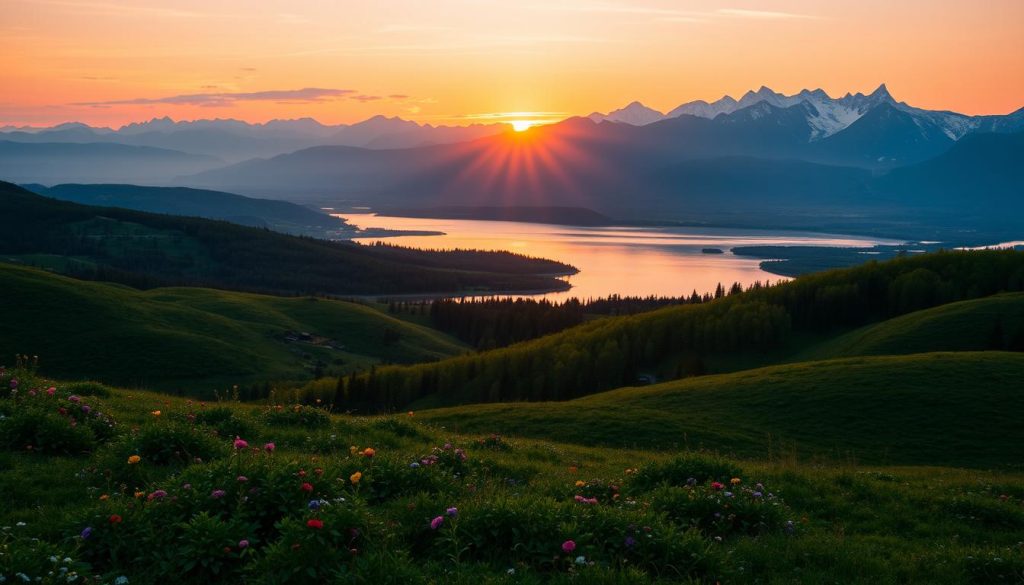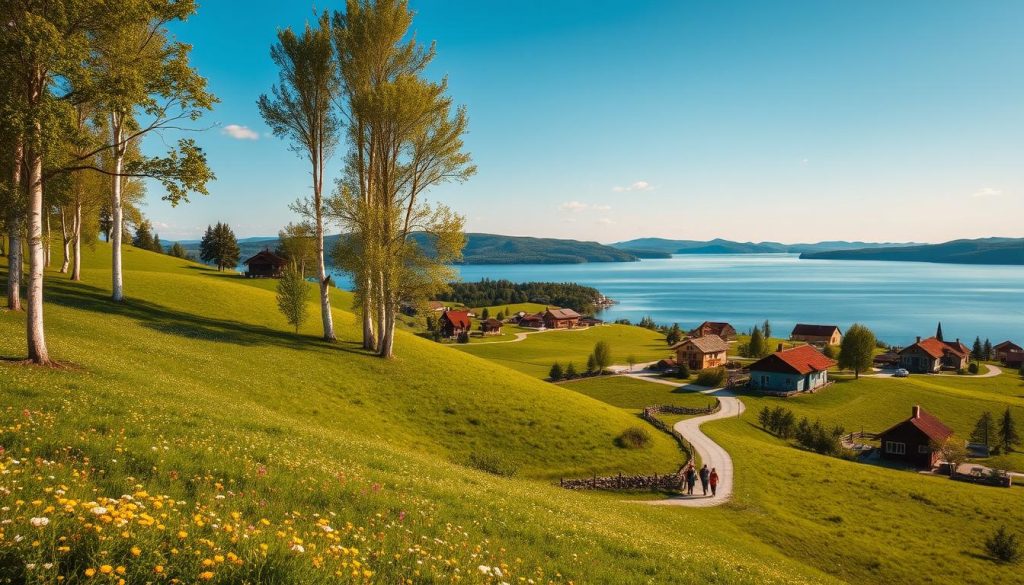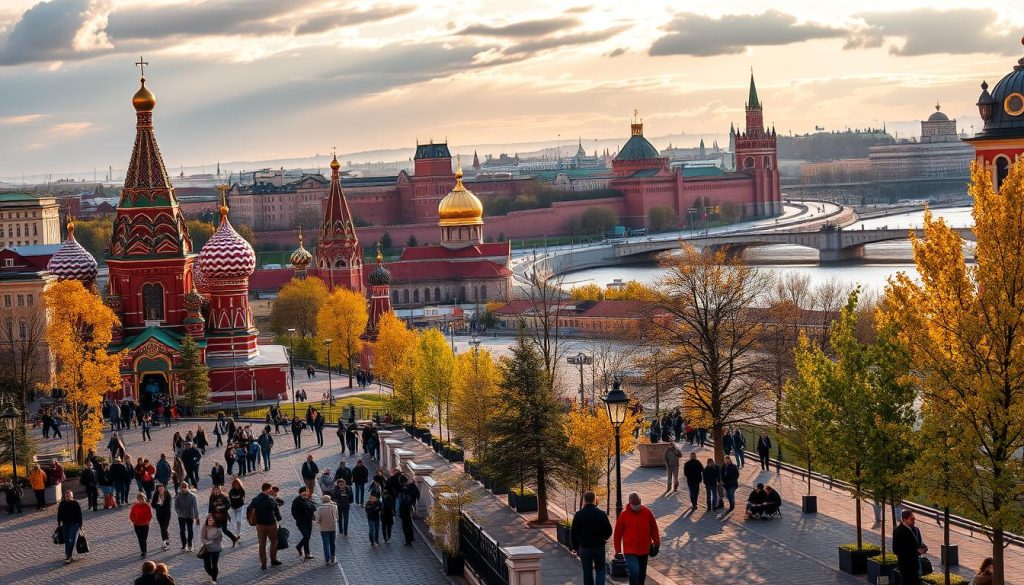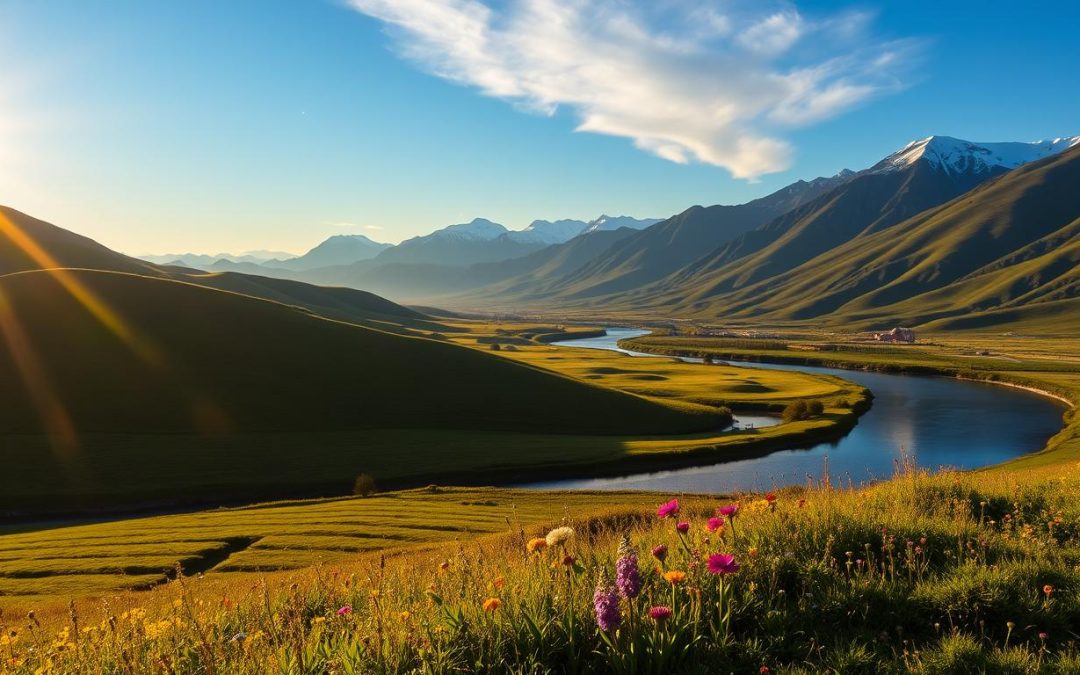Have you ever wondered when the best time to explore a vast and diverse country like Russia might be? Planning your visit around the weather can make all the difference in your travel experience. This guide will help you navigate the seasonal changes and choose the perfect time for your adventure.
Russia’s climate varies dramatically across its regions, from the freezing winters of Siberia to the mild summers of Moscow. Understanding these patterns ensures you pack appropriately and enjoy your trip to the fullest. Whether you’re chasing the Northern Lights or exploring historic cities, timing is key.
This guide is based on up-to-date travel and weather research, offering clear and actionable tips. You’ll learn how to balance high tourist demand with the benefits of off-peak travel. Let’s dive into the details and make your journey unforgettable.
Key Takeaways
- Discover the ideal seasons for visiting Russia based on weather conditions.
- Learn how seasonal variations impact your travel experience.
- Get tips for balancing high tourist demand and off-peak benefits.
- Understand the importance of packing for Russia’s diverse climates.
- Explore how timing can enhance activities like Northern Lights viewing.
Understanding Russia’s Unique Climate
From icy tundras to mild coastal breezes, Russia’s climate is a study in contrasts. Its enormous landmass, spanning over 17 million square kilometers, creates a wide range of weather patterns. Proximity to water, altitude, and geographic location all play a role in shaping its unique climate.
Geographic Influences and Seasonal Drivers
Russia’s geography is a key factor in its weather. Siberia, known for its harsh winters, experiences temperatures that can drop below -13°F (-25°C). In contrast, western regions like Moscow enjoy milder winters, with January averages around 18°F (-8°C). These variations are driven by the country’s vast size and diverse terrain.
Altitude also impacts local weather. Mountain ranges like the Ural Mountains create distinct microclimates. Coastal areas, such as St. Petersburg, benefit from the Baltic Sea’s moderating influence. Understanding these factors helps you prepare for the weather you’ll encounter.
Temperature Variations Across Regions
Temperature fluctuations across Russia are dramatic. In Moscow, July is the warmest month, with averages around 65°F (19°C). Meanwhile, Siberia’s winters are among the coldest on Earth. St. Petersburg sees January lows of 25°F (-16°C), while southern regions like Sochi enjoy milder winters.
These differences highlight the importance of planning your trip around the season. Whether you’re chasing the Northern Lights or exploring historic cities, knowing the local weather ensures a smoother experience. Packing for these extremes is essential to stay comfortable.
By understanding Russia’s unique climate, you can make informed decisions about when and where to visit. This knowledge not only enhances your travel but also helps you avoid unexpected weather surprises.
Russia: Best Months for a Weather-Savvy Trip
Timing your visit to Russia wisely ensures you enjoy the best weather and fewer crowds. The country’s vast size means weather conditions vary widely, so planning around the right season is key. Whether you’re drawn to the warmth of summer or the charm of winter, understanding the climate helps you make the most of your trip.

Balancing Weather Conditions and Tourist Demand
Choosing the best time to visit involves balancing favorable weather with manageable tourist numbers. Summer is popular for its warmth and long days, but it also brings crowds. Winter, while cold, offers unique experiences like snowy landscapes and festive markets.
Shoulder seasons—spring and autumn—provide a sweet spot. You’ll enjoy milder weather and fewer tourists, making it easier to explore iconic landmarks. This balance ensures a more relaxed and enjoyable travel experience.
Monthly Weather Breakdown for Smart Travel
Here’s a detailed look at monthly weather trends to help you plan:
| Month | Average Temperature (°F) | Precipitation (inches) |
|---|---|---|
| January | 18 | 1.5 |
| April | 45 | 1.2 |
| July | 65 | 2.8 |
| October | 48 | 2.0 |
Summer months like July are warm but can be rainy. Winter, especially January, is cold but perfect for snowy activities. Spring and autumn offer mild temperatures and fewer crowds, making them ideal for cultural exploration.
By aligning your travel plans with these trends, you can avoid extreme weather and enjoy a smoother journey. Whether you’re chasing the Northern Lights or strolling through historic cities, timing is everything.
Winter in Russia: Embrace the Chill and Snow
Winter transforms Russia into a magical wonderland, where snow blankets the landscape and traditional activities thrive. This season offers a unique charm, turning the country into a snowy paradise. From troika rides to ice festivals, there’s no shortage of ways to enjoy the frosty beauty.
Enjoying Winter Activities and Troika Rides
One of the most iconic winter experiences is a troika ride. These traditional horse-drawn sleighs glide through snowy forests, offering a glimpse into Russia’s rich cultural heritage. Ice festivals are another highlight, featuring intricate sculptures and lively celebrations.
Temperatures during this season can drop significantly, with averages ranging from 18°F (-8°C) in Moscow to -13°F (-25°C) in Siberia. Despite the cold, winter travel offers unique cultural experiences and cost-saving benefits. Fewer tourists mean you can explore iconic landmarks without the crowds.
However, unexpected weather surprises can occur. Always check up-to-date forecasts before your trip. This ensures you’re prepared for any sudden changes in conditions. Packing warm layers and waterproof gear is essential to stay comfortable.
Winter in Russia is more than just a time of cold; it’s a season of wonder and tradition. Whether you’re marveling at ice sculptures or enjoying a troika ride, this magical time of year promises unforgettable memories.
Summer Adventures: Warmth and Extended Days
With long days and pleasant warmth, summer is ideal for discovering Russia. This season transforms the country into a vibrant playground, offering endless opportunities for exploration. From bustling cities to serene coastal areas, there’s something for every traveler.

Exploring Top Destinations Under the Summer Sun
Summer in Russia is marked by extended daylight hours, often lasting until late evening. This makes it the perfect time to visit iconic destinations like Moscow and St. Petersburg. These cities come alive with outdoor festivals, open-air markets, and cultural events.
Coastal areas like Sochi offer a different experience, with warm breezes and beachside relaxation. Inland regions, such as Siberia, provide milder temperatures compared to their harsh winters. This diversity ensures every traveler finds their ideal summer escape.
Outdoor attractions flourish during this season. Parks, gardens, and historic landmarks are at their best, inviting you to explore. Festivals celebrating music, art, and food add to the vibrant atmosphere, making summer a memorable travel experience.
“Summer in Russia is a celebration of life, culture, and nature.”
From June to August, the weather is warm but not overwhelming, with average temperatures ranging from 65°F to 86°F. This makes it comfortable for sightseeing and outdoor activities. Whether you’re strolling through a city square or hiking in the countryside, summer’s charm is undeniable.
Plan your trip during this season to enjoy the best of Russia’s outdoor and cultural offerings. With fewer crowds than peak tourist months, you’ll have more space to soak in the beauty and warmth of this incredible country.
The Transition: Experiencing Spring and Autumn in Russia
Spring and autumn in Russia bring a unique charm, offering a quieter and more authentic travel experience. These shoulder seasons are perfect for those who want to explore without the summer crowds or winter chill. The gradual shift in temperatures and the transformation of the landscape make these times of year truly special.
What to Expect During Shoulder Seasons
During spring, the snow melts, and the countryside comes alive with blooming flowers. Autumn paints the forests in vibrant hues of orange and red. Both seasons offer mild temperatures, making it comfortable to explore cities and nature alike. Rainfall is moderate, so you’ll rarely face weather disruptions.
One of the biggest advantages of traveling during these seasons is the reduced number of tourists. You’ll have more space to enjoy iconic landmarks and a chance to connect with locals on a deeper level. Lower prices on accommodations and tours add to the appeal, making it a budget-friendly time to visit.
However, the weather can be unpredictable. Pack layers to stay prepared for sudden changes. Despite this, the seasonal charm of spring and autumn makes them a rewarding experience for any traveler. Whether you’re strolling through Moscow’s parks or hiking in the countryside, these months offer a perfect blend of comfort and discovery.
City Spotlight: Moscow’s Seasonal Attractions
Moscow, a city of contrasts, offers unique experiences in every season. From snowy winterscapes to vibrant summer scenes, it transforms dramatically throughout the year. Whether you’re planning your time to visit or seeking a deeper experience, understanding its seasonal charm is key.

Navigating Moscow’s Cold Winters and Warm Summers
Winter in Moscow is a magical experience. Snow blankets the city, turning landmarks like Red Square into picturesque scenes. Temperatures often drop to 18°F (-8°C), so dressing in layers is essential. Public transport, including the metro, remains reliable, making it easy to explore despite the cold.
Summer brings warmth and energy to the city. With average highs of 65°F (19°C), it’s the perfect time to visit outdoor attractions like Gorky Park. The long daylight hours allow for extended sightseeing, and local festivals add to the vibrant atmosphere.
Cultural highlights shine in every season. In winter, the Ice Festival showcases stunning sculptures. Summer features open-air concerts and markets. These events offer a glimpse into local life and traditions, enriching your visit.
To truly experience Moscow like a local, embrace the seasonal rhythm. In winter, warm up with a cup of tea at a cozy café. In summer, join the crowds at outdoor events. Each season offers a unique way to connect with this dynamic city.
City Spotlight: St. Petersburg’s Cultural Seasons
St. Petersburg, a cultural gem, offers a unique experience in every season. From its grand museums to its historic streets, this city transforms with the changing weather. Whether you’re drawn to the warmth of summer or the snowy charm of winter, planning your time to visit ensures you make the most of your trip.
Seasonal Highlights and Must-See Landmarks
St. Petersburg’s landmarks take on new life with each season. In summer, the city’s canals and gardens are in full bloom, perfect for leisurely strolls. The Hermitage Museum and Peterhof Palace are must-see attractions, offering a glimpse into Russia’s rich history.
Winter brings a magical atmosphere, with snow-covered streets and festive markets. The Church of the Savior on Spilled Blood looks even more stunning against a snowy backdrop. Spring and autumn offer milder weather, ideal for exploring the city’s parks and riverside views.
Optimizing Your Visit in Different Weather Conditions
To fully enjoy St. Petersburg, consider the weather during your time to visit. Summer is warm, with temperatures averaging 65°F (19°C), but it’s also the busiest season. Winter, while cold, offers fewer crowds and unique experiences like ice skating on the Neva River.
Here’s a breakdown of seasonal weather patterns:
| Season | Average Temperature (°F) | Precipitation (inches) |
|---|---|---|
| Summer | 65 | 2.8 |
| Winter | 25 | 1.5 |
| Spring | 45 | 1.2 |
| Autumn | 48 | 2.0 |
Spring and autumn are ideal for those seeking a quieter experience. The weather is mild, and the city’s charm shines through without the summer crowds. Pack layers to stay comfortable, as temperatures can vary throughout the day.
No matter when you visit russia, St. Petersburg’s cultural heritage and seasonal beauty will leave a lasting impression. Plan your trip wisely to enjoy the best time visit this iconic city.
Planning Your Weather-Savvy Trip: Tips & Tricks
Planning a trip to Russia requires careful preparation, especially when dealing with its diverse and extreme climates. Whether you’re visiting in the freezing winter or the mild summer, having the right guide and strategies can make your journey smoother and more enjoyable.

Packing Essentials for Extreme Climates
When traveling to Russia, packing the right gear is crucial. The country’s weather can shift dramatically, so being prepared is key. Here’s a checklist to ensure you’re ready for any temperature:
- Heavy coats: Essential for winter trips, especially in Siberia.
- Insulated gloves and hats: Protect against freezing temperatures.
- Layered clothing: Perfect for fluctuating weather in spring and autumn.
- Waterproof boots: Keep your feet dry during rainy or snowy days.
Don’t forget to check the forecast before your time to visit. This helps you pack appropriately and avoid surprises.
Booking Strategies and Travel Preparation
Booking your travel wisely can save you time and money. Here are some tips to consider:
| Season | Booking Tips |
|---|---|
| Winter | Book early for festive events and check for flight deals. |
| Summer | Plan ahead for popular destinations and higher prices. |
| Spring/Autumn | Take advantage of shoulder season discounts and fewer crowds. |
Flexibility is key. Consider adjusting your itinerary based on weather conditions and local events. This ensures you make the most of your day without unnecessary stress.
By following these tips, you’ll be well-prepared for your travel to Russia. Whether you’re exploring historic cities or enjoying natural wonders, proper planning enhances your experience.
Seasonal Festivals and Local Experiences
Immerse yourself in the vibrant cultural tapestry of Russia through its seasonal festivals. These events offer a unique window into the country’s traditions, blending history with modern celebrations. Whether you’re visiting a bustling city or a quiet town, there’s always a festival to enhance your experience.
Embracing Russia’s Rich Cultural Celebrations
From winter markets in Moscow to summer street parties in St. Petersburg, Russia’s festivals are as diverse as its landscapes. The Russian Winter Festival, held from mid-December to mid-January, is a highlight. It features traditional performances, ice sculptures, and festive markets. This event transforms the city into a winter wonderland, offering activities like ice skating and troika rides.
Summer brings its own charm with events like the Moscow International Film Festival. This festival attracts filmmakers and enthusiasts from around the world, showcasing the best of cinema. It’s a perfect time to visit russia if you’re a fan of art and culture.
Here are some must-see festivals:
- Russian Winter Festival: Celebrate Christmas and New Year with traditional songs, dances, and crafts.
- Moscow International Film Festival: Explore global cinema in one of Europe’s cultural hubs.
- White Nights Festival: Enjoy extended daylight hours with concerts and performances in St. Petersburg.
“Festivals in Russia are not just events; they are a way to connect with the heart and soul of the country.”
These celebrations allow you to experience the local way of life. You’ll find food fairs offering traditional dishes, craft markets showcasing handmade goods, and performances that tell stories of Russia’s past. Timing your visit to coincide with these events ensures a richer, more authentic experience.
Plan ahead to make the most of your trip. Book accommodations early, especially during peak festival seasons. This ensures you don’t miss out on these unforgettable moments. Whether it’s a winter market or a summer street party, these events will leave a lasting impression on your day in Russia.
Conclusion
Planning your trip around the right time ensures a memorable experience. Whether you’re drawn to the snowy charm of winter or the vibrant energy of summer, understanding the climate helps you make the most of your journey. This guide provides insights into seasonal attractions and city-specific highlights, helping you choose the ideal time to visit.
From the refreshing spring blooms to the lively autumn festivals, each season offers unique opportunities. Use the tips shared here to book your flight and organize your itinerary. Timing your trip wisely ensures you enjoy fewer crowds and better weather.
Your adventure, planned smartly around the right time of year, will be a highlight of your travels. Embrace the magic of each season and create unforgettable memories.
The above is subject to change.
Check back often to TRAVEL.COM for the latest travel tips and deals.
